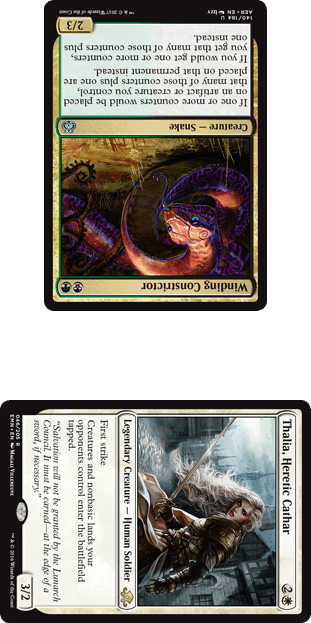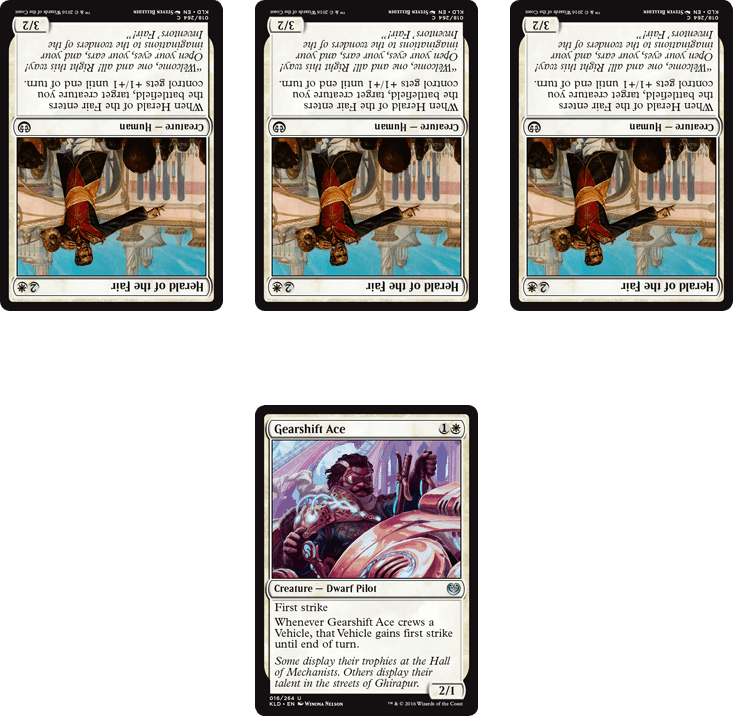Striking First
First strike. It's a mechanic that has been a part of Magic since the very beginning.
From its iconic appearance on the dueling pair of White Knight and Black Knight to its lesser known foray on cards like Lance, there it was. It's been here the whole time, consistently dealing damage first since 1993.
And through 23-plus years of gameplay, there are a few important lessons to learn about the mechanic. There are some things that may not be apparent at first sight. (Or first strike.)
A little while back, I wrote this article about the flying mechanic and its many uses. Today, we're going to do a similar take on first strike.
Ready to make the first blow? Here we go!
Strike One
First strike can often read as innocuous, a cute little line of text on some creature, but it has a big gameplay impact. When you boil down what first strike is trying to do, it essentially amounts to this: it helps your creature scare off other creatures in combat.
Like flying, it can be a form of evasion—but unlike flying, it can also be a massive form of defense. We'll look at both today.
But first, in what kind of situations do you want a creature with first strike?
First strike falls into the "creature combat keyword" space. That means that it is going to be quite relevant if you're playing against a deck with opposing creatures. However, it does next to nothing if your opponent is creatureless or is only playing a few big finishers that you won't be able to first strike down anyway.
To use the same example from the Invention of Flying: if you're playing against a creatureless Paradox Engine deck, first strike isn't going to do anything for you. Similarly, if you're playing against a control deck full of Torrential Gearhulks as its primary win condition, first strike is unlikely to do much for you. Unlike flying, which could help you get past the Gearhulks on the ground, first strike is, at best, going to maybe scare off a Gearhulk attack if you have enough of it. Not super likely.
However, if you're playing any matchup where there are creatures on both sides, first strike can be extremely potent. And while something like flying is strong because of its ability to push through on offense, first strike has an entire additional layer with its defensive capabilities—something which flying doesn't carry nearly as much.
Let's take a look at the two different modes of first strike.
A Striking Offensive
On offense, first strike is very strong early and becomes significantly weaker as the game goes on.
Early on, it can essentially be evasion. Your opponent would need to make a one-for-zero—a "chump block"—to deal with your creature coming through.
If you attack with Thalia, Heretic Cathar and your opponent has just a Winding Constrictor back to block, your Thalia almost certainly isn't getting blocked. Your opponent would be throwing away their creature for nothing.

However, that scenario quickly changes if you add any two-power creature into the situation—let's say another Winding Constrictor. If your opponent has two Winding Constrictors, they can double block your Thalia. First strike happens, killing one off, and then normal damage takes your Thalia down.
Now, there is a bit of a risk here on your opponent's end. If you have a removal spell or pump spell, you could take down two of your opponent's cards for just one of yours. But, generally, as the board gets clogged, attacking with first strikers becomes less and less useful because they are easier to pick off by just blocking with plenty of creatures.
If your deck is full of removal, that certainly ups the strength of first strike. If your deck is very aggressive and looking to push through damage, that also ups the power of first strike since you will want to push for damage early in the game as much as possible and the late game isn't quite as what you're playing for.
But what if you're planning on being defensive?
Defense First
If you were to ask most Magic players if first strike was an aggressive or defensive mechanic, I think the off-the-cuff answer would be aggressive. It pushes your creatures through, cares about power, and it even has the word strike in the name!
However, for all its power on offense, the place where first strike can really shine is on defense. I would argue that first strike is far more powerful defensively than offensively. Here's why.
On offense, your opponent can double (or triple, or quadruple, or . . .) block to ensure your first-strike creature goes down. They can get past first strike's inherent advantage of hitting first simply by using multiple creatures.
However, on defense, they can't. You're assigning your first striker as a single blocker for their attacker. And it can be immensely hard to get through a defensive first-strike creature.
Take a look at this situation from Kaladesh Limited: you have a Gearshift Ace, and your opponent has three Herald of the Fairs.

You have one creature. Your opponent has three. But you have first strike!
If you attack, your opponent can just double (or triple) block, and the result will be the same as if your creature didn't have first strike: you will trade with one of the creatures.
But on defense? You can hold all three back with your one 2/1 first striker. Unless you're at a low enough life total where throwing away a Herald of the Fair makes sense, your opponent probably doesn't want to attack here.
This is only compounded further when you have multiple first strikers! We call it a "wall of first strike" here in Magic R&D (which is probably a confusing term, considering that our game also has walls with first strike), meaning that every additional first-strike creature makes attacking as your opponent even harder.
To illustrate this, let's look at a slightly different scenario: this time, there are Cowl Prowlers on the loose!
You have three Gearshift Aces, but your opponent has two Cowl Prowlers. Your opponent has such huge creatures!
You shouldn't attack the Aces into them (unless your opponent is at 2, anyway): you'll just be throwing creatures away.
. . . But once again, on defense it's a different story. Your opponent can't attack you with the Cowl Prowlers here! You can triple block one, striking it down while leaving all of your Aces entirely unharmed.
That's the real power of first strike. One of the most common mistakes I see in Limited with first strike is people attacking with first strikers to get damage through when actually they should be leaving them back to defend. You have to ask yourself: who is the beatdown here? And if the answer isn't you, then leaving your first striker untapped to negate your opponent's attacks is going to be the better direction.
Three Strikes, We're Out
Hopefully, you learned something about how to use first strike strategically today you can use to up your game. It's one of Magic's core mechanics, and the better you can use it, the better you'll be able to do.
While the mechanic can be hit or miss in Constructed depending on the matchup, in Limited it's almost always going to be relevant—and it is certainly a strong ability to factor in, regardless of whether you're playing offense or defense.
If you have any thoughts or questions on any of this, it's always great to hear from you! You can reach me on Twitter, Tumblr, or by sending me a good ol'-fashioned e-mail (in English, please) at BeyondBasicsMagic@gmail.com.
Talk with you again next week. Until then, may you always strike first!

